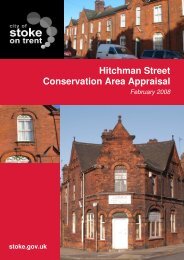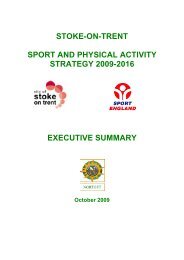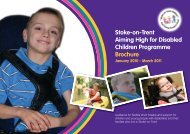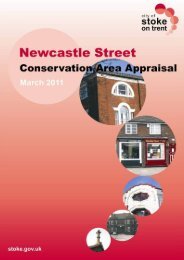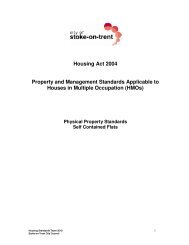Director of Public Health Annual Report 2012 [pdf] - Stoke-on-Trent ...
Director of Public Health Annual Report 2012 [pdf] - Stoke-on-Trent ...
Director of Public Health Annual Report 2012 [pdf] - Stoke-on-Trent ...
You also want an ePaper? Increase the reach of your titles
YUMPU automatically turns print PDFs into web optimized ePapers that Google loves.
Figure 16 shows that a child born with a low cognitive score into an affluent family has, by<br />
the age <str<strong>on</strong>g>of</str<strong>on</strong>g> six, a score that will be higher than some<strong>on</strong>e born with a high score into a family<br />
with a low socioec<strong>on</strong>omic status 1 . This suggests the need to invest in children from deprived<br />
backgrounds. It makes sense <strong>on</strong> productivity grounds since the evidence shows they are<br />
more likely to commit crime, become single teenage parents, and drop out <str<strong>on</strong>g>of</str<strong>on</strong>g> school 33 . Early<br />
interventi<strong>on</strong>s that partially remediate the effects <str<strong>on</strong>g>of</str<strong>on</strong>g> adverse envir<strong>on</strong>ments can reverse some<br />
<str<strong>on</strong>g>of</str<strong>on</strong>g> the harm <str<strong>on</strong>g>of</str<strong>on</strong>g> disadvantage and have a high ec<strong>on</strong>omic return. This is particularly relevant<br />
for the Local Authority as it takes <strong>on</strong> the resp<strong>on</strong>sibility for many public health services, and in<br />
particular those relating to school nursing and health visiting.<br />
Figure 16 Inequality in early cognitive development <str<strong>on</strong>g>of</str<strong>on</strong>g> children in the 1970 British<br />
Cohort Study, at ages 22 m<strong>on</strong>ths to 10 years<br />
Source: Marmot M (2010). Fair society, healthy lives: the Marmot review. Final <str<strong>on</strong>g>Report</str<strong>on</strong>g>.<br />
The remaining two items <str<strong>on</strong>g>of</str<strong>on</strong>g> lifestyle (5) and major causes <str<strong>on</strong>g>of</str<strong>on</strong>g> death (6) are highlighted in the<br />
first chapter <strong>on</strong> health status, and are an integral feature <str<strong>on</strong>g>of</str<strong>on</strong>g> the sec<strong>on</strong>d chapter <strong>on</strong> l<strong>on</strong>g-term<br />
c<strong>on</strong>diti<strong>on</strong>s. As expected, this report c<strong>on</strong>tinues to str<strong>on</strong>gly endorse these six priorities.<br />
Vulnerable Groups<br />
The inclusi<strong>on</strong> this year <str<strong>on</strong>g>of</str<strong>on</strong>g> surveillance indicators for vulnerable groups makes for interesting<br />
reading. In all 10 <str<strong>on</strong>g>of</str<strong>on</strong>g> the indicators, <str<strong>on</strong>g>Stoke</str<strong>on</strong>g>-<strong>on</strong>-<strong>Trent</strong> is performing worse than the England<br />
average. However, comparing 2009 and 2010, we have improved in six: low birthweight<br />
births; teenage pregnancy; children excluded from sec<strong>on</strong>dary school; older people receiving<br />
pensi<strong>on</strong> credit; drug misuse; and violent crime (and generally better than England average<br />
57 | P a g e


![Director of Public Health Annual Report 2012 [pdf] - Stoke-on-Trent ...](https://img.yumpu.com/32721490/59/500x640/director-of-public-health-annual-report-2012-pdf-stoke-on-trent-.jpg)





